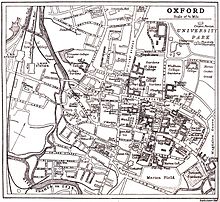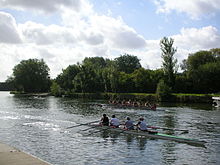The Isis



"The Isis" (/ˈaɪsɪs/ EYE-siss) is an alternative name for the River Thames, used from its source in the Cotswolds until it is joined by the Thame at Dorchester in Oxfordshire. The modern form of the name, first recorded c.1540,[a] relates to the Egyptian goddess Isis.[b] The deity was venerated throughout the Roman Empire, and was worshipped at the Temple of Isis – near the Thames in Londinium – during the Roman occupation. Notably, the Isis flows through the city of Oxford.
Rowing
[edit]The name "Isis" is especially used in the context of rowing at the University of Oxford. A number of rowing regattas are held on the Isis, including Eights Week, the most important Oxford University regatta, in the Trinity term (summer), Torpids in the Hilary term (early spring) and Christ Church Regatta for novices in the Michaelmas term (autumn). Because the width of the river is restricted at Oxford, rowing eights normally have a staggered start near Donnington Bridge and must then aim to "bump" the eight in front (i.e. catch up and touch or overlap with it sufficiently). The leading eight aims to "row over" (i.e. finish the race without being bumped).

There used to be ornate wooden barges on the river bank at the southern end of Christ Church Meadow to house rowing facilities and for viewing races. Now the barges are gone and there are boathouses instead a little further down the river near the confluence with the River Cherwell. Poplar Walk in Christ Church Meadow is used as a route to and from the boathouses.
The name "Isis" is also used for the men's second rowing eight of Oxford University Boat Club, who race against Goldie, the men's second crew of the Cambridge University Boat Club, before the annual Oxford vs. Cambridge Boat Race on the Thames in London.
Angling
[edit]The Isis, like much of the Thames, has long been popular among anglers for its freshwater fish, including trout and crayfish. The Oxford region is home to several angling clubs. W. F. Wallett, a popular Victorian clown, shares in his memoirs his own anecdote about fishing in the Isis with the celebrated circus proprietor Pablo Fanque:
For a few days I amused myself with Pablo Fanque fishing in the Isis. Pablo was a very expert angler, and would usually catch as many fish as five or six of us within sight of him put together. This suggested a curious device. You must know that Pablo is a coloured man. One of the Oxonians, with more love for angling than skill, thought there must be something captivating in the complexion of Pablo. He resolved to try. One morning, going down to the river an hour or two earlier than usual, we were astonished to find the experimental philosophic angler with his face blacked after the most approved style of the Christy's Minstrels.[3]
Name
[edit]
The Isis is an alternative name for the stretch of the Thames from its source in the Cotswolds – near Thames Head – to its confluence with the River Thame at Dorchester on Thames.[a]
The association between Oxford and the Egyptian goddess Isis might be explained by her role as Stella Maris – "Star of the Sea" ..."the divine protector of sailors and fishermen".[c][d] The Latin Stella Maris – "Star of the Sea" – relates to Mary, mother of Jesus and Christianity. The worship of Isis (as Stella Maris) was associated with the transformation of Roman society – away from paganism – towards the shining light of Christianity.[e][f][g][h]
It has in the past been conjectured that the Romano-British name for the Thames ("Tamesis") is a conflation (joining together) of its two main tributary names, the River Thame and the Isis.
The conflation theory might explain the reason why the Thames has retained a trailing 's' – but the River Thame has not.[i]
The conflation theory was proposed and endorsed by antiquarians and scholars during the middle ages, including Ranulf Higden, [j] John Leland,[6] and William Camden (1551–1623).[6] In the late seventeenth century, the Welsh scholar Edward Lhuyd – second Keeper of the Ashmolean Museum in Oxford – endorsed the conflation theory in Parochailia (1695).[6]
Known name variants for the upper Thames, recorded during the medieval period, include Ysa or Usa (14th century),[j] Isa, Ise (14th century),[a] and Isis or Ouse (16th century).[a] The name variants Isa, Ise, suggest a P-Celtic origin and may derive from Brittonic 'is' or 'isca' , from whence many common river names derive.[k][l] The European Danube river was known by its Celtic name Istros.[9] A more local example is the River Isbourne, which is a hybrid of Brittonic 'is' and English bourne.
The modern form of the name, first recorded c.1540,[a] is a reference to the Egyptian goddess Isis,[b] possibly the result of a revival of interest in classical Roman antiquities during the sixteenth century, and influenced by the ideas of the antiquarian John Leland (c. 1503–1552), who endorsed the conflation theory (Tam + Isis).[m] It is unlikely that the earlier names were related to the Egyptian goddess.[n]
The origin of the modern form was possibly influenced by the study of religion at the University of Oxford, the association of the Egyptian goddess with Christianity,[o] and the association of the Thames with the Egyptian goddess.[p] It may also have been influenced by the revival of interest in classical Roman antiquities in the 16th century, and the conflation theory endorsed by the antiquarian John Leland.
It is possible that the earlier name Isa had a different meaning that was lost when replaced by a similar sounding name.
Name legacy
[edit]The Morris Isis name was first used by Morris Motors Limited of Oxford on a six-cylinder car made from 1929 to 1931. It was resurrected on a six-cylinder car from the British Motor Corporation in the 1950s. The name died out in 1958.
HMP Isis is a Category C Young Offenders Institution in England operated by His Majesty's Prison Service, adjacent to HMP Belmarsh and HMP Thameside near the River Thames in the Woolwich area of South East London.
Each of the Formula Student cars manufactured by the Oxford Brookes racing team used the name ISIS in the beginning of its chassis number.[citation needed] ISIS is then succeeded by the year number; for example, ISIS XII was the 2012 chassis, nicknamed "Miss Piggy".[citation needed] This continued until the 2016 season, when the naming convention changed to use an OBR prefix.
The ISIS neutron source is named after the river Isis.[10]
See also
[edit]- Port Meadow
- Folly Bridge
- River Cherwell
- Alice's Adventures in Wonderland
- Rowing on the River Thames
- Henley-on-Thames
- Tributaries of the River Thames
- List of rivers in England
Notes
[edit]- ^ a b c d e Watts – English Place-Names
River ISIS ..."An alternative name for the Thames above its junction with the Thame, used particularly in Oxford...[1]- Isa c.1350, c.1400.
- Ise 1347, 1387, c.1540.
- The Isis c.1540.
- Isis or Ouse 1577.
- ^ a b Ackroyd – Thames: Sacred River
..."The god of the Egyptians, Isis, has been generally associated with the Thames ...[2] - ^ Rodgers – Ancient Rome...
..."As her worship spread around the Mediterranean from its origins in Alexandria, Isis became known as Stella Maris (star of the sea) the divine protector of sailors and fishermen ...[4] - ^ See also Isis > In the Greco-Roman world > Festivals > ...The first festival was the Navigium Isidis...
- ^ The relationship between the Egyptian goddess and Christianity was complex, since the cult of Isis was itself pagan.
- ^ See also Paganism ...Ritual sacrifice was an integral part of ancient Graeco-Roman religion and was regarded as an indication of whether a person was pagan or Christian...
- ^ See also Persecution of pagans in the late Roman Empire.
- ^ See also Isis > Possible influence on Christianity.
- ^ P H Reaney – English Place Names
..."The earliest forms of Thames, Tamesa, Tamesis
..."What is most noteworthy here is the preservation of the inter-vocalic 's' ...[5] - ^ a b Ackroyd – Thames: Sacred River
..."Higden writes
..."Tamisia seems to be composed from the names of two rivers, that are the Thama and the Ysa or Usa ...[6]..."Tamisia videtur... ...Thama et Ysa aut Usa
– Ranulf Higden (c.1280–1364). - ^ SPNS – Brittonic Language in the Old North
ï[s]- "A verbal root meaning ‘refresh’, and so ‘heal’, is seen as an element in several ancient river names, with connotations of ‘vigour, swift movement’ ...[7] - ^ P H Reaney – English Place Names
..."Axe, Exe, Esk, Usk, Wiske all forms of Brit. isca...[8] - ^ Ackroyd – Thames: Sacred River
..."John Leland in his Itinerary (1546)...announced that[6]..."Isis riseth 3 myles from Cirencestre"
- ^ Ackroyd – Thames: Sacred River
..."It is more than probable that the Ysa and Usa of Higden's account are in fact from the Celtic...[6] - ^ See Isis > Possible influence on Christianity.
- ^ See Londinium > Temple of Isis.
References
[edit]Citations
[edit]- ^ Watts 2007, p. 334.
- ^ Ackroyd 2007, p. 26.
- ^ Wallett, W. F. (1870). Luntley, John (ed.). The Public Life of W.F. Wallett, the Queen's Jester: An Autobiography. London: Bemrose and Sons. p. 73.
- ^ Rodgers 2017, p. 426.
- ^ Reaney 1969, p. 72.
- ^ a b c d e f Ackroyd 2007, pp. 26–27.
- ^ James 2020, p. 158.
- ^ Reaney 1969, p. 77.
- ^ Roberts 2015, p. 62.
- ^ "ISIS Neutron Source". YouTube. Science and Technology Facilities Council. 11 March 2016. Archived from the original on 21 December 2021. Retrieved 14 June 2017.
Bibliography
[edit]- Ackroyd, Peter (2007). Thames: Sacred River. Chatto & Windus. ISBN 978-0701172848.
- de la Bédoyère, Guy (2013). Roman Britain: A New History. Thames & Hudson. ISBN 978-0500291146.
- Collingwood, W. G. (1988). The Lake Counties (1932). Revised by William Rollinson (1988). J.M. Dent & Sons. ISBN 0-460-04758-2.
- James, Alan G. (2020). "The Brittonic Language in the Old North, A Guide to the Place-Name Evidence, Volume 2" (PDF). Scottish Place-Name Society. Retrieved 3 March 2024.
- Moffat, Alistair (2019). To the Island of Tides; A Journey to Lindisfarne. Canongate Books. ISBN 978-1786896346.
- Rabbitts, Paul; Rabbitts, David (2022). Cotherstone: A Village in Teesdale. Amberley Publishing. ISBN 978-1398113831.
- Raithby, John, ed. (1819). Charles II, 1677 & 1678: An Act for Preservation of Fishing in the River of Seaverne. British History Online. pp. 892–893. Retrieved 30 April 2024.
- Roberts, Alice (2015). The Celts: Search for a Civilisation. Heron Books. ISBN 978-1784293321.
- Reaney, P. H. (1969). The Origin of English Place Names. Routledge & Kegan Paul.
- Rodgers, Nigel (2017). Ancient Rome: An Illustrated History. Lorenz Books. ISBN 978-0754834205.
- Watts, Victor (2007). The Cambridge Dictionary of English Place-Names. Cambridge University Press. ISBN 978-0-521-16855-7.
- Williams, Thomas (2023). Lost Realms: Histories of Britain from the Romans to the Vikings. William Collins. ISBN 978-0008171988.
